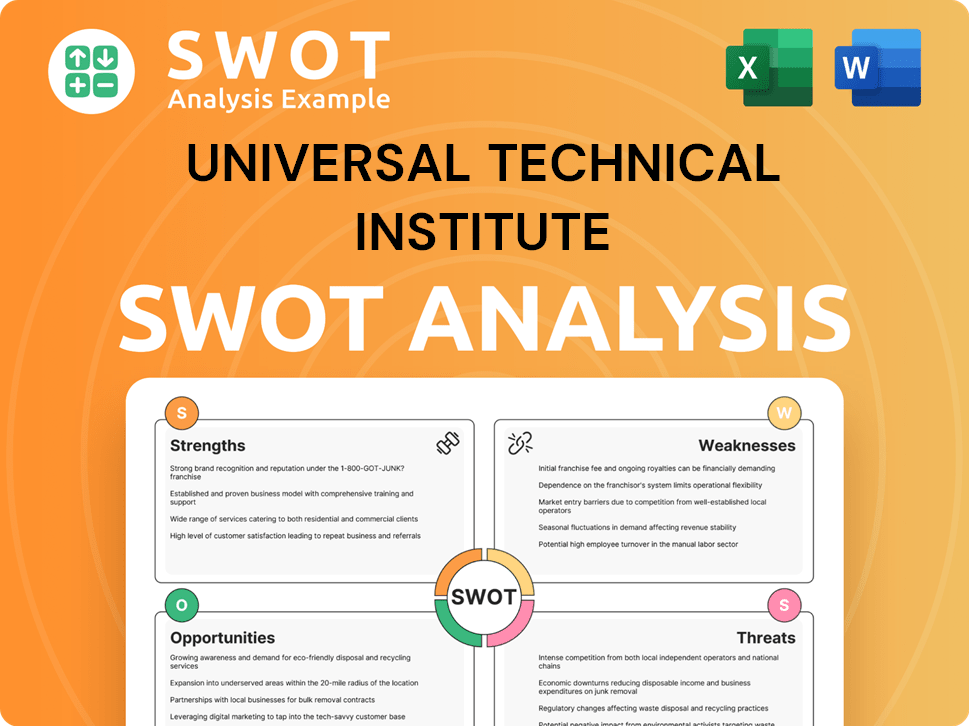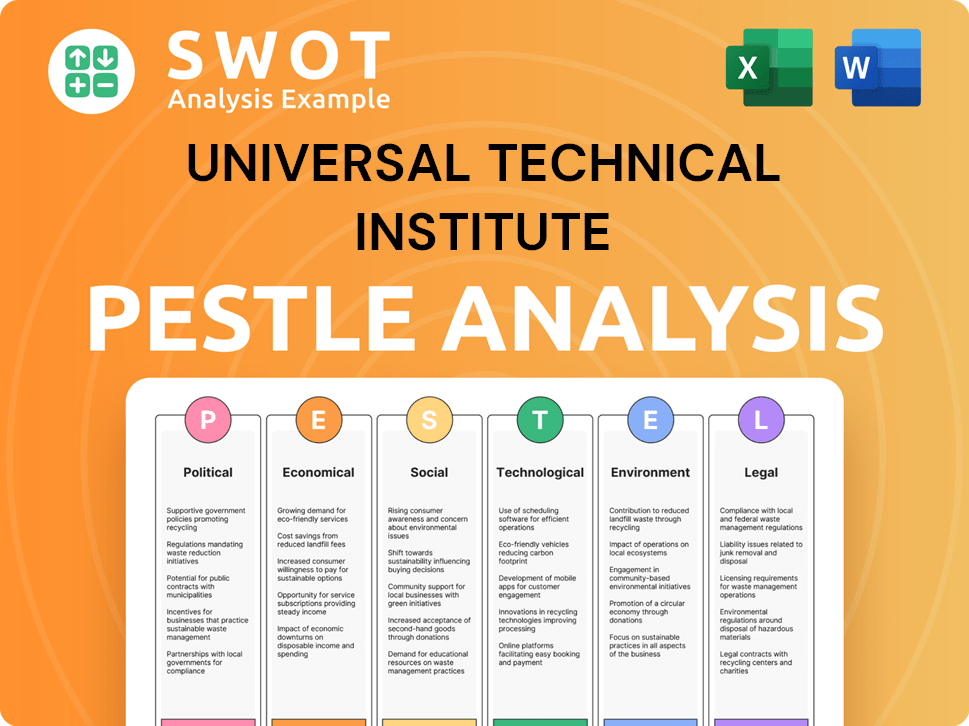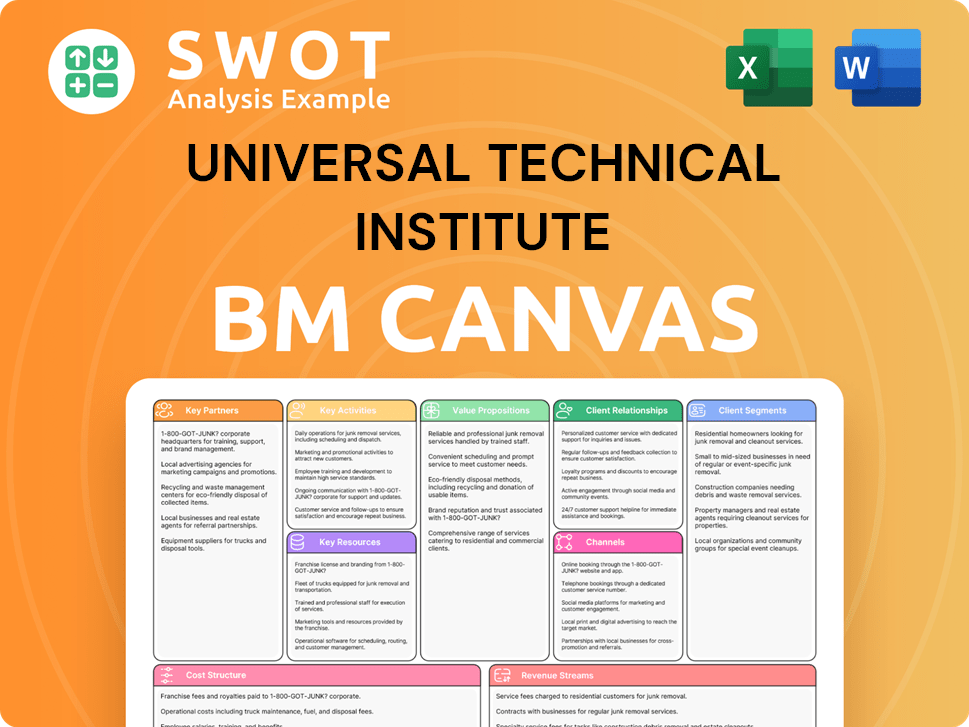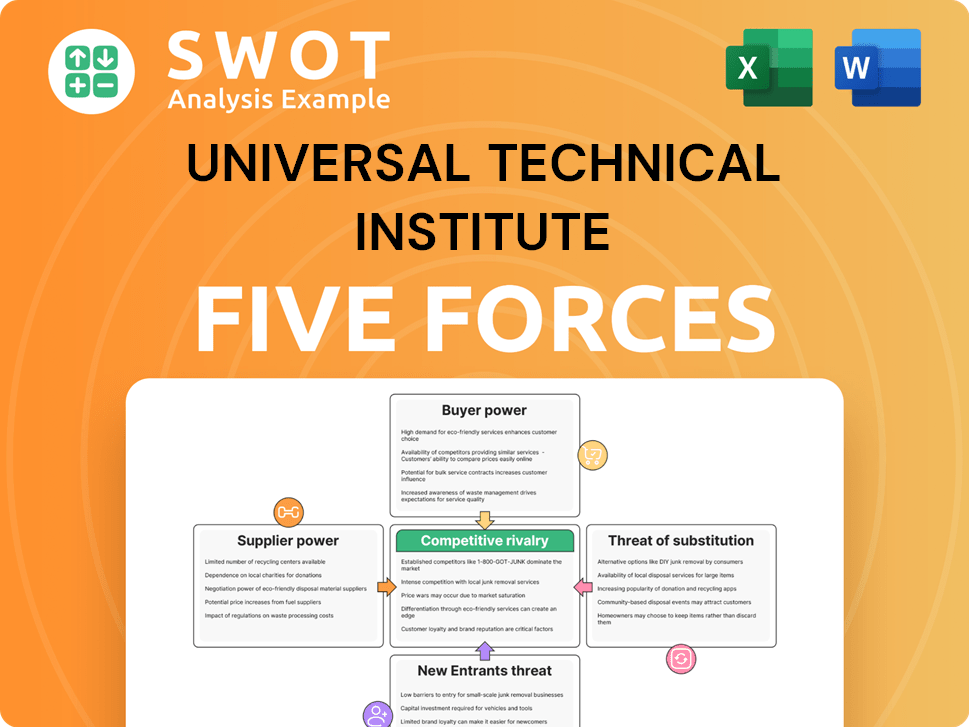Universal Technical Institute Bundle
How Does Universal Technical Institute Stack Up Against the Competition?
From a single auto repair school in 1965 to a nationwide leader, Universal Technical Institute (UTI) has charted an impressive course. But in the dynamic world of technical education, how does UTI truly measure up against its rivals? This analysis dives deep into the Universal Technical Institute SWOT Analysis, examining the key players and competitive dynamics shaping UTI's future.

Understanding the UTI competitive landscape is crucial for investors and strategists alike. This exploration will identify UTI's main competitors, analyze its market position, and uncover the factors driving its success. Furthermore, we'll compare UTI to other trade schools, providing a comprehensive UTI market analysis to help you make informed decisions in the ever-evolving automotive technician schools sector.
Where Does Universal Technical Institute’ Stand in the Current Market?
Universal Technical Institute (UTI) holds a significant position in the technical education sector. It focuses on training students for careers as technicians in various fields, including automotive, diesel, and healthcare through its Concorde Career Colleges division. The company operates across multiple campuses, providing specialized training programs designed to meet industry demands.
The company's value proposition centers on providing career-focused education. UTI aims to equip students with the skills and knowledge necessary for employment in their chosen fields. This focus on practical training and industry partnerships is a key element of its market strategy.
In fiscal year 2024, UTI reported total revenue of $732.7 million. The UTI division contributed $486.4 million, and the Concorde division contributed $246.3 million. The company's net income was $42.0 million, with an adjusted EBITDA of $102.9 million.
UTI anticipates consolidated revenue between $825 million and $835 million for fiscal year 2025, reflecting approximately 13% year-over-year growth. Adjusted EBITDA is projected to be between $124 million and $128 million. Total new student starts are expected to be between 29,000 and 30,000 in fiscal year 2025.
As of June 2025, UTI's market capitalization was $1.90 billion USD. The company's 'North Star Strategy' aims for approximately 10% revenue CAGR and an adjusted EBITDA margin approaching 20% through fiscal year 2029. This strategic focus underscores UTI's commitment to sustained growth and profitability.
UTI has shown consistent growth in average full-time active students, with an 11.1% increase in Q1 2025 and a 10.3% increase in Q2 2025. New student starts also grew significantly, with a 22.3% increase in Q1 2025 and a 21.4% increase in Q2 2025. This growth indicates a strong market position and increasing demand for its programs.
UTI's competitive advantages include its established market presence, specialized training programs, and strategic focus on growth. The company's countercyclical business model further supports its expansion, driven by rising enrollment and strategic initiatives. For more details on the company's structure, you can read about Owners & Shareholders of Universal Technical Institute.
- Strong revenue growth and profitability.
- Consistent increases in student enrollment.
- Strategic initiatives for long-term growth and profitability.
- Expansion through new campuses and programs.
Universal Technical Institute SWOT Analysis
- Complete SWOT Breakdown
- Fully Customizable
- Editable in Excel & Word
- Professional Formatting
- Investor-Ready Format

Who Are the Main Competitors Challenging Universal Technical Institute?
The competitive landscape for Universal Technical Institute (UTI) is primarily within the post-secondary education sector, specifically focusing on technical and vocational training. The competition includes other technical institutes and broader educational service providers. Understanding the UTI competitive landscape is crucial for assessing its market position and strategic challenges.
Several factors influence the competition, including program offerings, geographic reach, and learning modalities such as online or hybrid formats. The competitive dynamics also involve brand recognition, scale, and the ability to adapt to emerging trends in education and workforce needs. A thorough UTI market analysis should consider these elements.
Key competitors include institutions that offer similar training programs, such as Lincoln Technical Institute. Larger, diversified education companies also pose competition, leveraging their scale and brand recognition. The competitive environment may shift due to mergers, acquisitions, or the emergence of new educational models.
Direct competitors offer similar technical and vocational training programs. These institutions often focus on specific trades and compete for the same student demographic. Analyzing the strengths and weaknesses of these competitors is essential for UTI's strategic planning.
Indirect competitors include broader educational service providers that may offer a wider range of programs or different learning formats. These competitors can challenge UTI by providing alternative educational paths. Examining their market strategies helps understand the competitive dynamics.
Key competitors include Lincoln Technical Institute, Strategic Education, Perdoceo Education, ITT Educational Services, and Apollo Education Group. These institutions compete with UTI for market share in the technical and vocational education sector. Understanding their market positions is critical.
Other notable competitors include Bright Horizons Family Solutions, Stride, Grand Canyon Education, Adtalem Global Education, American Public Education, TAL Education Group, Graham, and Laureate Education. These institutions may compete with UTI in various ways, such as offering a broader range of programs or different learning modalities.
Emerging players or shifts in the market, such as new online learning platforms or specialized corporate training programs, could also disrupt the traditional competitive landscape. Some sources also list PCI, YTI Career Institute, University of Northwestern Ohio, and Automotive Training Center as competitors. These competitors often focus on specific niches within skilled trades.
Mergers and alliances within the education sector can impact competitive dynamics by creating larger, more formidable entities. These changes can influence market share and the competitive balance. The competitive landscape is constantly evolving, requiring ongoing analysis.
Understanding UTI's competitive advantages and disadvantages is essential for strategic planning. These factors can influence its market share and overall performance. Analyzing these elements provides insights into UTI's strategic positioning and potential areas for improvement.
- UTI's advantages may include its established brand, specialized programs, and industry partnerships.
- Disadvantages could involve higher tuition costs compared to some competitors or a narrower program focus.
- Competition from online learning platforms and corporate training programs presents additional challenges.
- A thorough SWOT analysis is crucial for assessing UTI's position in the market.
For further insights into UTI's strategic direction, consider reading about the Growth Strategy of Universal Technical Institute. This will provide a deeper understanding of the company's plans and how it intends to navigate the competitive landscape.
Universal Technical Institute PESTLE Analysis
- Covers All 6 PESTLE Categories
- No Research Needed – Save Hours of Work
- Built by Experts, Trusted by Consultants
- Instant Download, Ready to Use
- 100% Editable, Fully Customizable

What Gives Universal Technical Institute a Competitive Edge Over Its Rivals?
The competitive landscape for Universal Technical Institute (UTI) is shaped by its strategic partnerships, specialized training programs, and established brand presence. These factors collectively contribute to UTI's ability to attract students and maintain a strong position in the technical education market. Understanding these advantages is key to assessing UTI's long-term viability and its ability to navigate the challenges posed by its competitors.
UTI's approach to workforce development, focusing on high-demand careers, allows it to cater to specific industry needs. The company's expansion strategies, including campus growth and program diversification, are designed to enhance its market reach and strengthen its competitive position. This proactive approach is essential for sustaining growth and profitability in a dynamic educational environment.
UTI's competitive advantages are significantly bolstered by its industry partnerships, specialized curriculum, and strong brand equity. These elements collectively position UTI favorably within the technical education sector, enabling it to attract students and maintain a competitive edge.
UTI has established partnerships with over 35 leading manufacturers, including BMW, Ford, and General Motors. These collaborations ensure the curriculum aligns with industry demands, providing students with access to current tools and technologies. Graduates often become preferred candidates for hiring, with some partners offering tuition reimbursement.
The company offers specialized technical education in areas such as automotive, diesel, and aviation. This targeted approach to workforce development ensures graduates possess the necessary skills and knowledge. The blend of digital and hands-on instruction prepares students for the demands of their chosen fields.
With 15 campuses across the U.S. and approximately 275,000 graduates, UTI has built significant brand equity. This extensive alumni network supports career placement and provides valuable connections for graduates. The 'North Star Strategy' focuses on growth and diversification to enhance its competitive edge.
UTI's strategic plan includes expanding its campus footprint and launching new programs. The company aims for approximately a 10% revenue CAGR and an adjusted EBITDA margin approaching 20% through fiscal year 2029. This demonstrates a commitment to long-term growth and profitability.
UTI's competitive advantages include strong industry partnerships, specialized programs, and a well-established brand. These factors help it stand out in the technical school competition. The company's focus on in-demand careers and its strategic initiatives further strengthen its position in the market.
- Industry-aligned curriculum and access to industry-standard tools.
- Targeted training in high-demand fields, such as automotive and diesel technology.
- Extensive alumni network and established brand recognition.
- Strategic growth plans, including campus expansion and program diversification.
Universal Technical Institute Business Model Canvas
- Complete 9-Block Business Model Canvas
- Effortlessly Communicate Your Business Strategy
- Investor-Ready BMC Format
- 100% Editable and Customizable
- Clear and Structured Layout

What Industry Trends Are Reshaping Universal Technical Institute’s Competitive Landscape?
The technical education sector is undergoing significant transformations, influenced by technological advancements, evolving workforce needs, and shifts in consumer preferences. These trends present both challenges and opportunities for Universal Technical Institute (UTI). Regulatory changes, particularly in federal student financial aid, and global economic fluctuations further impact the industry. Understanding the Revenue Streams & Business Model of Universal Technical Institute is crucial in this dynamic environment.
The competitive landscape for UTI is shaped by factors such as the increasing complexity of vehicles and machinery, which necessitates continuous curriculum updates. Simultaneously, the rise of online learning platforms and specialized corporate training programs introduces new competition. UTI must navigate these challenges while capitalizing on the strong demand for skilled trades professionals.
The technical education industry is experiencing rapid technological advancements, particularly in the automotive and healthcare sectors. There's a growing demand for skills-based training, reflecting a shift in consumer preferences. Regulatory changes, such as those affecting federal student financial aid, also play a crucial role.
UTI faces challenges from more agile online learning platforms and specialized corporate training programs. Declining demand for certain trades due to automation and increased regulatory scrutiny are potential threats. New market entrants focusing on niche areas could also intensify competition.
There's a strong and growing demand for skilled professionals in transportation, skilled trades, and healthcare. Emerging markets in electric vehicles (EVs) and renewable energy offer new program development opportunities. Strategic partnerships further enhance career placement prospects.
UTI is expanding its core automotive program to include Battery Hybrid Electric Vehicle and Electric Vehicle courses, with rollouts completed at several campuses. The company plans to open new campuses in fiscal years 2026 and 2027. The 'North Star Strategy' includes launching new programs and campuses annually.
UTI's proactive approach includes expanding programs, opening new campuses, and forming strategic partnerships. The focus on emerging technologies like EVs and renewable energy positions UTI for future growth. The "North Star Strategy" aims to launch at least six new programs annually between fiscal years 2026 and 2029.
- Expansion into EV and renewable energy training programs.
- Opening new campuses to increase accessibility.
- Strategic partnerships to enhance career placement.
- Continuous curriculum updates to meet industry demands.
Universal Technical Institute Porter's Five Forces Analysis
- Covers All 5 Competitive Forces in Detail
- Structured for Consultants, Students, and Founders
- 100% Editable in Microsoft Word & Excel
- Instant Digital Download – Use Immediately
- Compatible with Mac & PC – Fully Unlocked

Related Blogs
- What are Mission Vision & Core Values of Universal Technical Institute Company?
- What is Growth Strategy and Future Prospects of Universal Technical Institute Company?
- How Does Universal Technical Institute Company Work?
- What is Sales and Marketing Strategy of Universal Technical Institute Company?
- What is Brief History of Universal Technical Institute Company?
- Who Owns Universal Technical Institute Company?
- What is Customer Demographics and Target Market of Universal Technical Institute Company?
Disclaimer
All information, articles, and product details provided on this website are for general informational and educational purposes only. We do not claim any ownership over, nor do we intend to infringe upon, any trademarks, copyrights, logos, brand names, or other intellectual property mentioned or depicted on this site. Such intellectual property remains the property of its respective owners, and any references here are made solely for identification or informational purposes, without implying any affiliation, endorsement, or partnership.
We make no representations or warranties, express or implied, regarding the accuracy, completeness, or suitability of any content or products presented. Nothing on this website should be construed as legal, tax, investment, financial, medical, or other professional advice. In addition, no part of this site—including articles or product references—constitutes a solicitation, recommendation, endorsement, advertisement, or offer to buy or sell any securities, franchises, or other financial instruments, particularly in jurisdictions where such activity would be unlawful.
All content is of a general nature and may not address the specific circumstances of any individual or entity. It is not a substitute for professional advice or services. Any actions you take based on the information provided here are strictly at your own risk. You accept full responsibility for any decisions or outcomes arising from your use of this website and agree to release us from any liability in connection with your use of, or reliance upon, the content or products found herein.